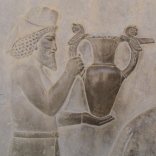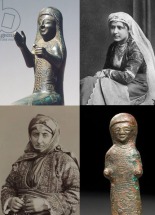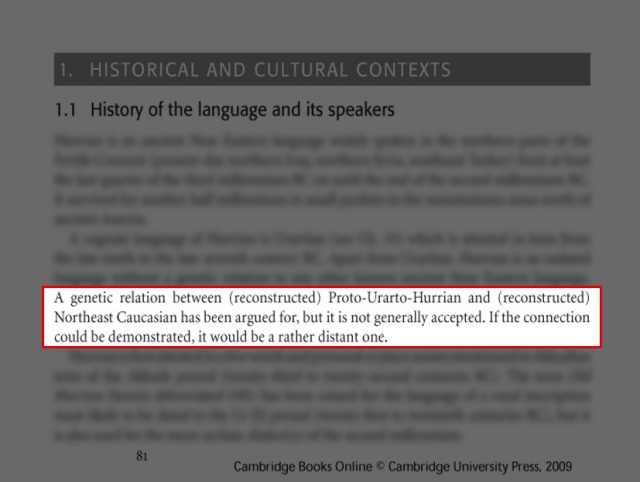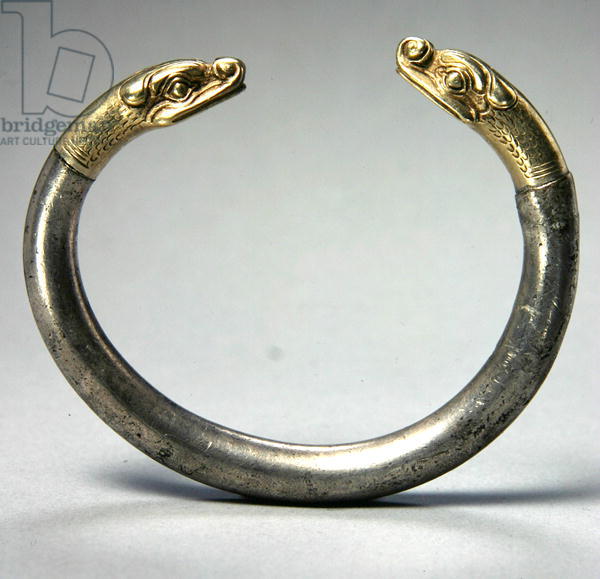Art of Urartu
Urartu was an Iron Age Armenian kingdom famed for one of the finest examples of ancient art. Urartu at its zenith had a profound cultural influence on its neighbors reaching as far as Asia and Europe. Supported by discoveries of Urartian artifacts inside Etruscan burials, it has been hypothesized that much of Etruscan culture has its origins in Urartu. [1] [2] Observations by Boris Piotrovsky suggest that decoration and production techniques of Scythian belts and scabbards were borrowed from Urartu. [3] The Urartian way of decorating cauldrons spread over the ancient world, and it is believed that Armenian art is based on the Urartian traditions. [4] [5]
Urartu and Armenia
That historic Armenian kingdom was in fact a continuation of the kingdom of Urartu also known as “Kingdom of Van” is apparent from ancient records. In the trilingual Behistun inscription, carved in 521 BC by the order of Darius the Great of Persia, the country referred to as Urartu in Assyrian is called Arminiya in Old Persian and Harminuia in Elamite. Armenia, Urartu, (Biblical) Ararat and Herminuia are therefore synonyms. Ancient people of the region did not distinguish Armenia from Urartu. Some modern scholars however proposed that Urartu fell to a Median invasion and was later replaced by Armenians. The evidence, however, for the so called “fall of Urartu” is absent. There are no records of invading Armenians.
Urartu in fact maintained its independence and power, going through a mere dynastic change, as a local Armenian dynasty (later to be called the Orontids) came to power. Ancient sources support this explanation: Xenophon, for example, states that Armenia, ruled by an Orontid king, was not conquered until the reign of Median king Astyages (585– 550 BC) – long after Median invasion of the late 7th century BC. [6]
Similarly, Strabo (1st century BC – 1st century AD) wrote that:
“In ancient times Greater Armenia ruled the whole of Asia, after it broke up the empire of the Syrians, but later, in the time of Astyages, it was deprived of that great authority …” [7]
Medieval Armenian chronicles corroborate the Greek sources. In particular, Movses Khorenatsi (5th c. AD) writes that Armenian prince Paruyr Skayordi helped the Median king Cyaxares and his allies conquer Assyria, for which Cyaxares recognized him as the king of Armenia, while Media conquered Armenia only much later—under Astyages. [8]
The name “Urartu” was simply stopped being used when the Persians stopped making trilingual and bilingual inscriptions and dropped Assyro-Babylonian altogether.
Different peoples throughout different times used to refer to Armenia by different names. The Sumerians in around 2,800 BCE called Armenia – Aratta, while the Akkadians that succeeded them in the second half of Third Millennium BCE called Armenia – Armani or Armanum. The Hittites who rose in the Second Millennium BCE called Armenia – Hayasa, while the Assyrians who arose in the second half of Second Millennium BCE called Armenia – Uruatri or Urartu (Ararat of the Bible). With their disappearance from the historical arena, the different names that they used to refer to Armenia and the Armenian people disappeared with them. However, Armenia and the Armenian people, always found the strength for renewal throughout the long millennia of their epic history and continued to fight on for both preservation and progress. [9]
Genetics of Urartu
Genetic evidence too shows that Armenians are native to the lands inhabited by Urartians. After elaborate research prof Dr. Richard Villems and colleagues of the University of Tartu (Faculty of biology and geography Institute of molecular and cell biology) have concluded in 2004:
“In our study the ancestry of the Armenians was traced back to different parts of Armenia, Georgia, Azerbaijan and Turkey, illustrating the fact that historic Armenia was a much larger territory than that of the present Republic of Armenia”.
Litvinov S. and colleagues have also noted in a paper from 2008:
“Armenians are a separate ethnic group, which originated from Neolithic tribes of the Armenian Uplands” [10]
A similar statement was made by M.M. Banoie et. al. in 2008:
“The Armenians are a nation and an ethnic group originating from the Caucasus and eastern Anatolia, where a large concentration of this community has remained, especially in Armenia.” [11]
The language of Urartu
However the most frequently cited argument against the Urartu-Armenian connection is linguistics. Some argue that people of Urartu did not speak an Armenian language, rather they supposed Urartians spoke a language related to Northeast-Caucasian languages. This hypothesis was first proposed by Igor M. Diakonoff who was instructed on the matter by Sergei Anatolyevich Starostin. Starostin’s theories have met considerable skepticism and his Altaic theory is controversial to say the least. Starostin has embarked on a journey to connect as many ancient languages as he can to North-Caucasian. Including Yeniseian, Altaic, Tibetan, Japanese and Austric. Urartian and its older relative Hurrian he also wrongly connected to North-Caucasian. This theory however is not generally accepted in the academic circles. Moreover both Diakonoff and Starostin were not versed in Armenian making their judgment on Hurro-Urartian a difficult task. As the Cambridge University encyclopedia of ancient languages describes:
“A genetic relation between (reconstructed) Proto-Urarto-Hurrian and (reconstructed) Northeast Caucasian has been argued for, but it is not generally accepted. If the connection could be demonstrated, it would be a rather distant one.” [12]
The Urartian scribes seemed to have been utilizing various alphabets, including native hieroglyphs. The most comprehensive studies have shown affinity to the Armenian language.
According to the German Orientalist A. D. Mordtmann, Urartian language was specifically Armenian, and it was only necessary to turn to an Armenian dictionary to discover the meaning of every word in the inscriptions. Dr. Mordtmann deciphered Urartian cuneiform inscriptions which in his words were written in one of early Armenian dialects. He also deciphered some Mesopotamian inscriptions using Armenian. [13]
The Armenian scholar S. Ayvazyan has also demonstrated in his extensive work (Urartian-Armenian lexicon and comparative – historical grammar”, 2011) that Armenian and Urartian languages are very much related. He summarizes by saying:
- Of the 230-250 Urartian words identified to date, 156 have their parallels in Armenian, thus comprising 62-68 percent of the established Urartian lexicon.
- Of the 156 parallel words, 95, almost 61 percent, are native and, therefore, cannot have been borrowed from Urartian (if, indeed, such a separate language ever existed).
- A large percentage of the parallel words are such that rarely infiltrate from one language to another (for instance, pronouns, basic (ad)verbs, subsidiary words, etc.)
…
- In the group of 65-68 words in the available Urartian lexicon with the most secure identification, (the words whose meanings are defined by the bilingual inscriptions and/or corresponding logograms), in general, 47 words, around 66-69 percent, have Armenian parallels. Moreover, 31 of these words are native; seven, borrowed and only nine words are of unknown origin.
- There are also numerous Armenian roots in various proper names attested in Urartian.
The examination of these points unequivocally brings us to the following conclusion: …The above mentioned facts prove that the larger part of the lexicon – the most frequently occurring, which forms the basis of the Urartian inscriptions – has its parallels in Armenian.
Bearing in mind that the Armenian-Urartian parallel word(root)s are (1) ubiquitous, (2) present in all groups of the identified lexicon, and (3) mostly native Armenian words, we can without doubt claim that the language preserved in the Urartian texts (which in scholarly literature is known as Urartian) is cognate to Armenian or is the early stage of it.” [14]
And thus, from linguistic, genetic, geographic, historic and cultural perspectives we can safely say that Armenia alone is the true heir of Urartu. With its art and sophistication admired by cultures of the past and present. Armenian national art still bears the cultural torch lid by the ancestors inhabiting of the Armenian Highlands.
Sources:
1) Maxwell, M., Hyslop KR Urartian Bronzes in Etruscan Tombs, Iraq, XVIII, 2, 1956
2) Pallottino, M. (1958). “Urartu, Greece and Etruria“. East and West (Rome) 9 (1–2)
3) Пиотровский Б. Б. Искусство Урарту VIII—VI вв. до н. э. (“The Art of Urartu, 8th-6th century BC“). (Hermitage, Leningrad, 1962
4) Пиотровский Б. Б. Ванское царство (Урарту) (kingdom of Van (Urartu)), Eastern Literature Publishing House, Moscow, 1959
5) Аракелян Б.Н. Клад серебряных изделий из Эребуни (Silver treasures excavated at Erebuni) Soviet Archaeology, 1971, Vol. 1
6) Xenophon.Cyropedia. 3.7. Translated by Henry Graham Dakyns.
7) Strabo Geographica 11.13.5
8) Movses Khorenatsi. History of Armenia, 5th Century (Հայոց Պատմություն, Ե Դար). Annotated translation and commentary by Stepan Malkhasyants. Gagik Sarkisyan (ed.) Yerevan: Hayastan Publishing, 1997, 1.21, pp. 100–101. ISBN 5-540-01192-9.
9) Gevork Nazarian (http://www.armenianhighland.com/)
10) Litvinov S, Kutuev I, Yunusbayev B, Khusainova R, Valiev R, Khusnutdinova E (2008) Alu insertion Polymorphisms in populations of the South Caucasus.
11) Banoei MM, Chaleshtori MH, Sanati MH, Shariati P, Houshmand M, Majidizadeh T, Soltani NJ, Golalipour M. (2008), Variation of DAT1 VNTR alleles and genotypes among old ethnic groups in Mesopotamia to the Oxus region.
12) Gernot Wilhelm (2008), The Ancient Languages of Asia Minor, Cambridge Books Online, Cambridge University Press 2009
13) Mordtmann A.D. About the cuneiform inscriptions of Armenia , Journal of the German Oriental Society, Leipzig, XXXI, 1877
14) Sargis Ayvazyan (2011), Urartian-Armenian lexicon and Comparative-Historical Grammer.
Images from the Armenian kingdom of Urartu:
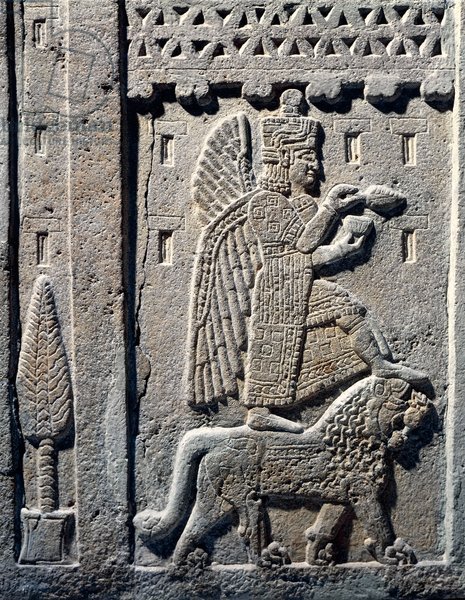
Relief depicting a winged god stepping on a lion from the kingdom of Urartu, Armenia, Hittite civilization
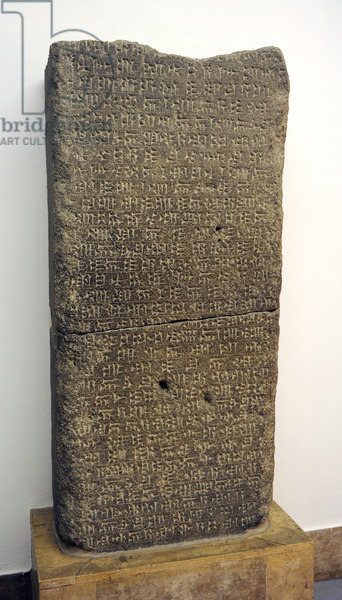
Urartu civilization. Stele of Rusa II, King of Urartu between around 680 BC and 639 BC. Cuneiform inscription commemorating the building of a canal to channel water to the city of Quarlini from the Ildaruni (Hrazdan River).
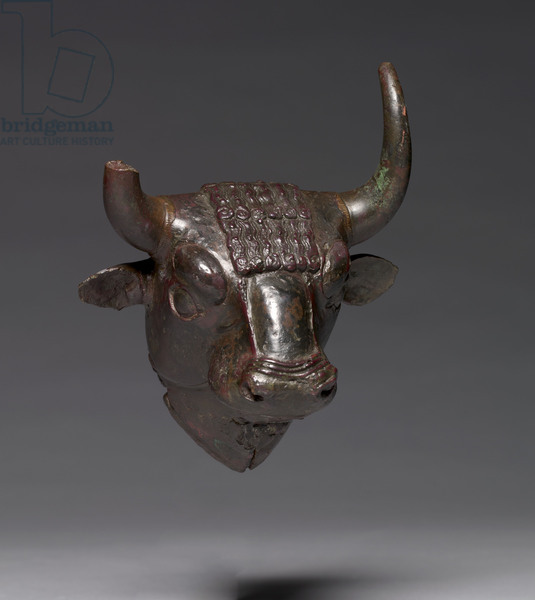
The kingdom of Urartu was contemporary with the Assyrian civilization. The Urartians produced elaborate bronze objects and probably passed on many of their metalwork traditions to the Achaemenian Persians. This bull head was probably one of four placed at cardinal points around the rim of a huge Urartian bronze cauldron.
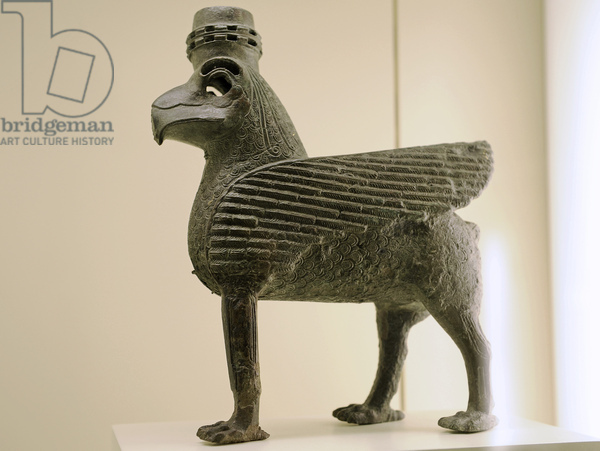
Urartu civilization. Bronze Sphinx. From Tushpa or Toprakkale. 7th century B.C. Turkey. Pergamon Museum. Berlin. Germany.
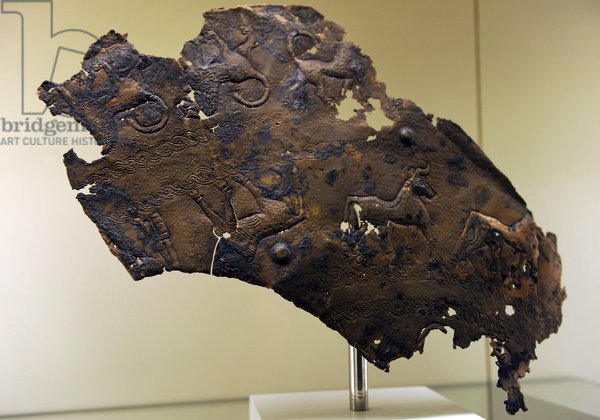
Urartu civilization. Remains probably of a decorated armor. From Tushpa 7th century B.C. Pergamon Museum. Berlin. Germany.


